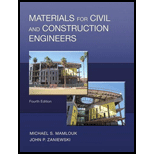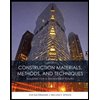
What are the two main classes of wood? What is the main use of each class? State the names of two tree species of each class.
The main classes of wood, use of each class, and the tree species of each class.
Explanation of Solution
Class of wood:
Wood is one of the best civil engineering material. Availability of this material is easy, and it is very economical in cost. At the same time, it is durable and easy to use. Based on the type of growth, it can be divided into two types. They are as follows:
- Endogenous type-It grows inward in longitudinal fibrous mass. In United States, the woods from endogenous type are not utilized for construction.
- Exogenous type-It grows outward across the horizontal section.
Uses:
- Exogenous tresses are only fit for engineering construction.
- The stem of endogenous tress is light; therefore, it has very limited engineering application. It can be utilized for ornamental works.
Trees species of each class:
- Bamboo, hemp, and cane come under endogenous type.
- Oak, pine, fir, and maple are the species of exogenous type.
Want to see more full solutions like this?
Chapter 10 Solutions
Pearson eText for Materials for Civil and Construction Engineers -- Instant Access (Pearson+)
Additional Engineering Textbook Solutions
Elementary Surveying: An Introduction To Geomatics (15th Edition)
Elementary Surveying (14th Edition)
Foundation Design: Principles and Practices (3rd Edition)
Structural Analysis (10th Edition)
Introduction to Java Programming and Data Structures, Comprehensive Version (11th Edition)
Introduction to Programming Using Visual Basic (10th Edition)
- Which is the least expensive wood? A. Ash B. Mahogany C. Cherry D. Pinearrow_forwardBriefly describe why engineered wood is stronger and has better properties than natural wood.arrow_forwardCollect a variety of samples of wood species used in construction and conduct various tests, such as:- Tension and compression tests.arrow_forward
- Problem: In ASTM D198 where it determines the flexure properties of wood such as modulus of rupture, modulus of elasticity, and failure conditions, determine the types of failure shown in each wood. Question 15 Use the editor to format your answerarrow_forwardWhat are the organisms that degrade wood ?arrow_forwardCompute the modulus of elasticity of the wood species whose stress–strainrelationship is shown in Figure 10.12, using both the SI and English units.Compare the results with the typical values shown in Table 1.1 in Chapter 1and comment about the results.arrow_forward
 Construction Materials, Methods and Techniques (M...Civil EngineeringISBN:9781305086272Author:William P. Spence, Eva KultermannPublisher:Cengage Learning
Construction Materials, Methods and Techniques (M...Civil EngineeringISBN:9781305086272Author:William P. Spence, Eva KultermannPublisher:Cengage Learning
